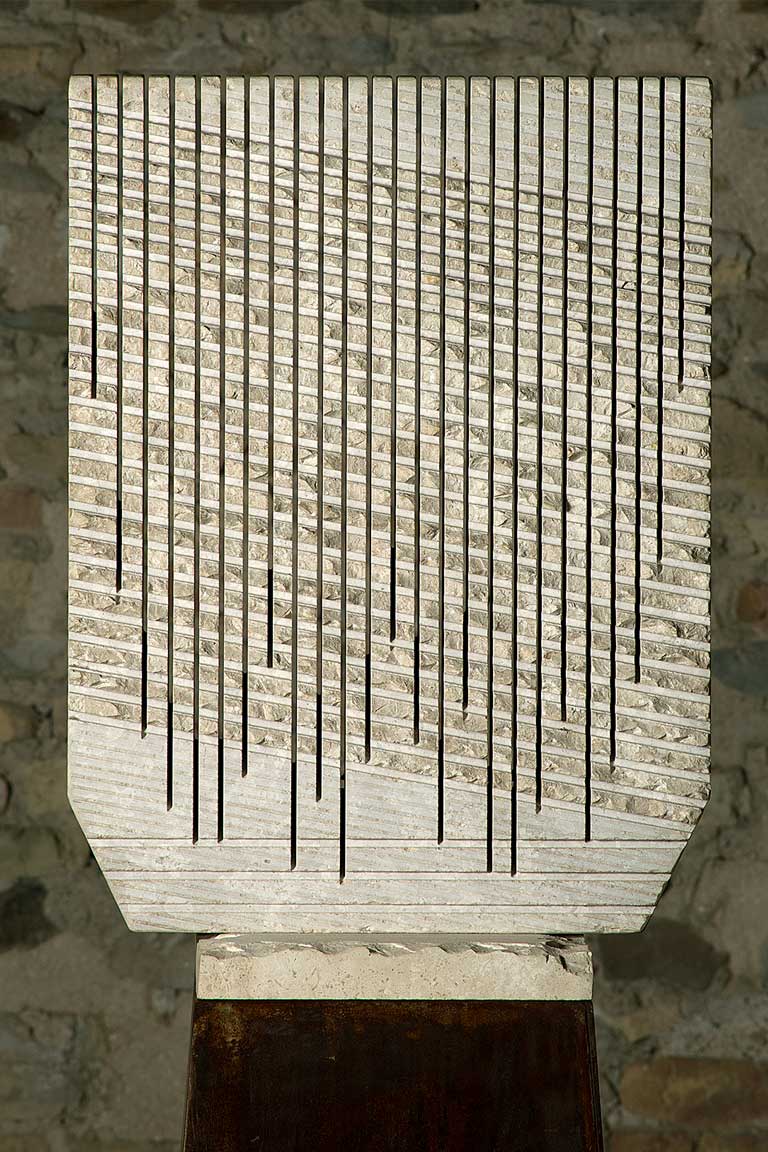Work: Sound stone
Original sculpture

Original
- Author
- Pinuccio Sciola
- Date
- 2012
- Period
- Contemporary
- Dimensions
- 70 cm high, 50 cm wide, 10 cm deep
- Technique
- sculpting, smoothing, cutting with diamond disc
- Material
- limestone
- Space
- 20th Century and Contemporary
Photo: Maurizio Bolognini. Museo Tattile Statale Omero Archive.
Description
“This is the extraordinariness of my adventure, of having managed to get inside the stone, to carve into it and to bring out sounds, sounds that are the primary elements of the universe,”- Pinuccio Sciola.
“Sound Stone” is an abstract limestone sculpture, created by Sardinian artist Pinuccio Sciola in 2012. It has been on show at the Museo Omero since 2024, thanks to the “The Senses of Art between Aesthetics and Inclusion” project which won the 2022-23 PAC competition. The sculpture is a white and beige stone rectangle, 70 centimetres high, 50 wide, and 10 deep, where vertical cuts intersect with engraved oblique lines.
The cuts and engravings form a grid on the surface, revealing small squares (about 1 centimetre per side) that feel uneven and coarse to the touch, like the mountains from which they originate. In contrast, the sides and top are smooth and polished, and the back is less rugged. The sculpture narrows at the bottom, like a sort of inverted trapezoid, and rests on a limestone base. The piece can be experienced with the eyes, encountered with the hands, and listened to in-depth.
Giuseppe Sciola, Sciola (1942-2016), known as Pinuccio, has been revealing the magic of the sounds of stone in his artistic work since the early 1990s.
Maria Sciola describes her father’s work in this way: “Stone, for him, was not an inert substance to be shaped but an entity pulsating with its own life, with which he felt the need to engage in an open and dynamic dialogue. The material was no longer solely relegated to visual and tactile functions but could be perceived through a third sense: hearing.” When its surface is stimulated using hands or fragments of a similar stone, the piece can vibrate and emit ancestral sounds, convey the power of nature to the participant and, in the case of limestone, set free the memory of water — a liquid and sometimes metallic, crystalline sound.
In the late 1990s, Sciola moved on from the sonic possibilities of basalt to engage with a very different material: limestone, a sedimentary, fossil-bearing, rock created by the accumulation of corals and shells in water. These sculptures relate the secret of creation itself but speak a modern language thanks to their distinctive craftsmanship: symmetrically crossing lines, modular grid cuts, or elegant vertical segments that, in some cases, render the stone transparent and elastic.
Investigating sonorous rock became steadily more fundamental in Pinuccio Sciola’s work. His sounding stones are among the highest expressions of his artistic journey and the notes they produce have inspired original creations in contemporary experimental music.
Project “The Senses of Art between Aesthetics and Inclusion”
The artwork was acquired by the Sciola Foundation thanks to funds from the 2022-23 PAC competition, the Contemporary Art Plan of the Directorate General for Contemporary Creativity of the Ministry of Culture. The Museo Omero won the competition with its “The Senses of Art between Aesthetics and Inclusion” project which aimed to showcase Sciola’s work in an accessible and multi-sensory context.
The caption of the sculpture includes a version in Braille and, for people in wheelchairs, there is an accessible table nearby with various materials to help comprehend the work:
- Two boxes with pieces of basalt and limestone for tactile exploration
- Some books on the artist’s background with a magnifying lamp for visually impaired visitors
- Two multisensory books that describe Sciola and his “Sonorous Stone” in easy-to-read language, in Braille, in audio format via audiopen, and in AAC (Augmentative and Alternative Communication). These books were created by two students with autism who attend the Liceo Artistico E. Mannucci in Ancona, as part of the 2023-24 PCTO (Paths for Transversal Skills and Orientation) programme.
Beside the table is a tablet showing a short documentary about the artist. It was filmed in his Giardino Sonoro in Sardinia and features Maria Sciola, his daughter, who talks about Pinuccio and his poetic vision. The language in the five-minute video is designed to be meaningful also for visually-impaired people. The video has audio description, subtitles, and translation into LIS (Italian Sign Language).
